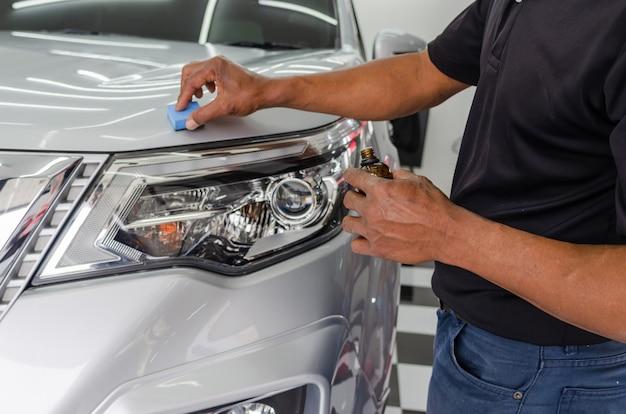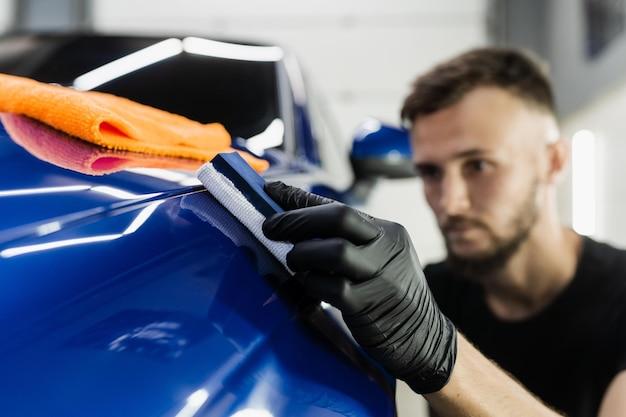Welcome to our comprehensive blog post on the topic of buffing ceramic coating. If you’re a car enthusiast or a car owner looking to protect your vehicle’s paintwork, you’ve likely heard of ceramic coating. This innovative protective layer has gained popularity for its ability to provide exceptional gloss and long-lasting durability. However, as with any coating, over time, it may develop imperfections or show signs of wear. This raises the question: Can you buff ceramic coating?
In this blog post, we will delve into the intricacies of ceramic coating maintenance and address common concerns about buffing ceramic coating. We’ll explore whether buffing is a viable option, how to properly maintain ceramic coating, and how to handle scratches or imperfections. So, whether you’re a ceramic coating aficionado or simply curious about the world of car care, this blog post will provide you with valuable insights and advice to keep your ceramic-coated vehicle looking its best.
Can You Buff Ceramic Coating
The Lowdown on Buffing Ceramic Coating
If you’re a proud car owner who loves keeping your ride looking shiny and new, chances are you’ve heard of ceramic coating. But what about buffing ceramic coating? Can you give it a little buff to make it even more lustrous? Let’s dive into the world of ceramic coating and find out if buffing is a good idea!
Understanding Ceramic Coating
Ceramic coating is a popular method of protecting your car’s paintwork from scratches, swirl marks, and UV damage. It’s like giving your car a suit of armor that keeps it looking fresh and glossy for longer. The coating forms a protective layer on top of the paint, bonding with the surface to create a barrier against environmental contaminants.
The Buffing Dilemma
Now, here’s where things get interesting. While ceramic coating provides a strong shield against minor scratches and swirl marks, it doesn’t make your car invincible. Over time, the coating may develop some imperfections, such as light scratches or water spots. That’s where buffing comes into the picture.
Buffing: The Art of Reviving
Buffing is a technique used to restore the shine and smoothness of a car’s surface. It involves using a machine, along with a polishing compound, to carefully remove a thin layer of paint or coating. While buffing can be a game-changer for regular car paint, things are a bit different when it comes to ceramic coating.
The Delicate Nature of Ceramic Coating
Ceramic coating, unlike traditional paint, is much more delicate. It has a limited thickness, typically ranging from 1-3 microns. Buffing can potentially wear down this thin layer, compromising the protective properties of the coating. So, before grabbing that buffing machine, it’s essential to consider the risks involved.
The Gentle Touch Approach
While buffing ceramic coating may not be recommended, there are alternative methods to address its imperfections. One option is using a mild polishing compound with a soft microfiber cloth. This gentle approach can help minimize the appearance of light scratches without compromising the integrity of the coating.
Prevention is the Best Protection
To avoid the need for buffing or extensive maintenance, it’s crucial to take preventive measures. Regularly washing your car with a pH-neutral shampoo, drying it using a microfiber towel, and avoiding abrasive chemicals or automatic car washes can go a long way in preserving the ceramic coating’s shine.
Maximizing the Life of Your Ceramic Coating
Ultimately, the best strategy is to prioritize the longevity of your ceramic coating by following proper maintenance practices. While minor imperfections may show over time, they are a small price to pay for the superior protection ceramic coating provides. So, resist the temptation to grab that buffing machine and instead focus on caring for your coating to keep your car looking top-notch.
So, can you buff ceramic coating? Technically, you can, but it’s not recommended due to the delicate nature of the coating. Instead, opt for gentle methods to address minor imperfections and prioritize preventive maintenance for long-lasting shine. Remember, a little TLC goes a long way in keeping your ceramic-coated car turning heads wherever it goes!
FAQ: Can You Buff Ceramic Coating
As a car enthusiast, you might have heard about the wonders of ceramic coating. It’s a protective layer that can keep your car’s paint looking glossy and pristine for years. But what happens when it starts showing signs of wear and tear? Can you buff ceramic coating? We’ve gathered answers to some frequently asked questions to help you navigate the world of ceramic coating maintenance and buffing.
Does Clay Bar Remove Ceramic Coating
Clay bar is a fantastic tool for removing contaminants like dirt and grime from your car’s surface. However, it’s not designed to remove ceramic coating. In fact, clay bar glides smoothly over the ceramic coating, enhancing its shine rather than compromising it.
Why is Ceramic Coating Bad
Ceramic coating itself is not bad; in fact, it offers excellent protection for your car’s paint. However, it’s essential to understand that ceramic coating is not bulletproof. While it provides durability and resistance to minor scratches and swirl marks, it is not immune to damage from more severe impacts or abrasive treatment.
Does Vinegar Remove Ceramic Coating
Vinegar is a versatile household item, but unfortunately, it’s not the solution for removing ceramic coating. While vinegar can effectively remove certain stains, it won’t be able to break down the strong bond of ceramic coating. For proper removal, you may need to seek professional assistance.
Which is Better: Nano or Ceramic Coating
Nano and ceramic coatings are both excellent choices for protecting your car’s paint. Nano coating, also known as nanoceramic coating, utilizes nanotechnology to create a thin, hydrophobic layer. On the other hand, ceramic coating, also called glass coating, is an inorganic substance that forms a durable bond with the surface. Overall, ceramic coating tends to offer superior durability and longevity compared to nano coating.
What Happens When Ceramic Coating Wears Off
Over time, ceramic coating will start to wear off due to exposure to the elements, regular washing, and general use. When this happens, you may notice a decrease in hydrophobic properties and a gradual loss of shine. However, the underlying clear coat of your car’s paint should remain intact and protected.
How Often Should You Wash a Ceramic Coated Car
Maintaining a regular washing routine is crucial for preserving the quality of your ceramic coating. Washing your car every two weeks is generally recommended, as it helps remove contaminants before they have the chance to bond to the surface. However, be sure to use gentle, pH-neutral car wash products to avoid damaging the coating.
What Should You Not Do After Ceramic Coating
After applying ceramic coating, there are a few things to avoid to ensure its longevity and effectiveness:
- Avoid immediate washing: Give the coating at least 7 days to properly cure before washing the car.
- Avoid harsh chemicals: Stay away from acidic or abrasive cleaners that can compromise the coating’s integrity.
- Avoid automatic car washes: Opt for hand washing or touchless car washes to minimize the chances of unwanted scratches or damage.
How Do You Polish a Car with Ceramic Coating
If your ceramic coating has minor imperfections or swirl marks, you can polish the affected areas to restore the shine. It’s best to use a mild abrasive polish and a soft microfiber cloth. Apply gentle pressure in circular motions, gradually working on the problem areas until you achieve the desired results.
Can You Mess Up Ceramic Coating
While ceramic coating is highly durable, it is not indestructible. You can potentially mess up the coating by using aggressive techniques or products during washing, polishing, or maintenance. It’s vital to follow the manufacturer’s guidelines and exercise caution when performing any treatments on your ceramic coated car.
Does Ceramic Wax Fill in Scratches
Ceramic wax is designed to provide additional protection and boost the hydrophobic properties of your ceramic coating. However, it’s important to note that ceramic wax does not fill in scratches. It can, however, help reduce the visibility of light swirl marks and enhance the overall appearance of your car.
How Long Does Spray on Ceramic Coating Last
The durability of spray-on ceramic coatings may vary depending on the brand and application. On average, the lifespan of a spray-on ceramic coating can range from six months to a year. It’s essential to follow the manufacturer’s instructions and regularly evaluate the coating’s condition to determine when reapplication is necessary.
How Do You Maintain Ceramic Coating
To maintain the effectiveness of your ceramic coating, it’s essential to follow a few simple steps:
- Regular washing: Wash your car every two weeks to remove dirt and contaminants.
- Use a pH-neutral shampoo: Avoid harsh chemicals that can deteriorate the coating.
- Avoid automatic car washes: Hand wash or use touchless car washes to reduce potential damage.
- Apply ceramic wax: Apply ceramic wax every few months to boost protection and shine.
Can You Wash a Ceramic Coated Car
Absolutely! In fact, maintaining a regular washing routine is crucial for the longevity of your ceramic coating. Just make sure to use gentle, pH-neutral car wash products and soft microfiber cloths to avoid any scratching or damage to the coating.
Is Ceramic Coating a Gimmick
No, ceramic coating is not a gimmick. It is a reliable and effective protective measure to keep your car looking its best. While it’s not invincible, properly applied ceramic coating offers significant benefits and can greatly enhance the longevity and appearance of your beloved vehicle.
Can You Buff a Ceramic Coated Car
Yes, you can buff a ceramic coated car, but it’s crucial to exercise caution. Always use a mild abrasive polish and a soft microfiber cloth to avoid damaging the coating. When in doubt, it’s best to consult with professionals who specialize in ceramic coating maintenance to ensure the best results.
Can You Polish Scratches Out of Ceramic Coating
While ceramic coating provides a layer of protection against minor scratches, it cannot guarantee the complete removal of deeper scratches. However, for minor surface-level scratches, gentle polishing may help reduce their visibility. It’s essential to approach the polishing process with care and use appropriate products to avoid compromising the ceramic coating.
How Long Does Ceramic Coating Last on a Car
The duration of ceramic coating on a car can vary depending on multiple factors, including the quality of the coating, application technique, environmental conditions, and maintenance routine. Generally, ceramic coatings can last anywhere from two to five years. Regular evaluation and proper maintenance will help determine the right time for reapplication.
Is Car Wash Ceramic Coating Worth It
Car wash ceramic coating offers convenience and an added layer of protection for your vehicle. It makes cleaning easier by creating a hydrophobic surface that repels dirt and water. If you value convenience, reduced washing time, and enhanced protection, investing in car wash ceramic coating can be worth it.
Are Touchless Car Washes Safe for Ceramic Coating
Yes, touchless car washes are generally safe for ceramic coating. Unlike traditional car washes that utilize brushes, touchless car washes rely on high-pressure water jets and cleaning agents to remove dirt and grime. However, note that the quality and maintenance of individual car wash establishments can vary, so it’s important to choose reputable touchless car wash facilities.
Now armed with this knowledge, you can confidently navigate the world of ceramic coating and ensure your car stays protected and looking its best. Remember to follow proper maintenance techniques and seek professional help when needed. Happy buffing and happy driving!
Disclaimer: The information provided in this article is for general informational purposes only. It is not a substitute for professional advice. Always consult a qualified expert for specific guidance related to your vehicle.

